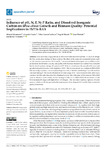Mostrar o rexistro simple do ítem
Influence of pH, N, P, N: P Ratio, and Dissolved Inorganic Carbon on Ulva ohnoi Growth and Biomass Quality: Potential Implications in IMTA-RAS
| dc.contributor.author | Alamrousi, Ahmed | |
| dc.contributor.author | Casais, E. | |
| dc.contributor.author | García-Cardesín, Érika | |
| dc.contributor.author | Masaló, Ingrid | |
| dc.contributor.author | Pintado, José | |
| dc.contributor.author | Cremades, Javier | |
| dc.date.accessioned | 2023-09-22T18:34:50Z | |
| dc.date.available | 2023-09-22T18:34:50Z | |
| dc.date.issued | 2022-11-03 | |
| dc.identifier.citation | Alamrousi, A.; Casais, E.; García-Cardesín, É.; Masaló, I.; Pintado, J.; Cremades, J. Influence of pH, N, P, N: P Ratio, and Dissolved Inorganic Carbon on Ulva ohnoi Growth and Biomass Quality: Potential Implications in IMTA-RAS. Aquac. J. 2022, 2, 285-301. https://doi.org/10.3390/aquacj2040017 | es_ES |
| dc.identifier.issn | 2673-9496 | |
| dc.identifier.uri | http://hdl.handle.net/2183/33505 | |
| dc.description.abstract | [Abstract] Ulva ohnoi has a big potential in IMTA-RAS fish–seaweed systems. In order to design the best production strategy in these systems, the effect of the main environmental factors, such as pH, nutrient concentration (N, P, and N: P ratios) and dissolved inorganic carbon (DIC), on the productivity, bio filtration capacity, and quality of the biomass obtained was studied. It is concluded that in closed systems, strong pH variations (7.9–10.1) do not influence the growth of U. ohnoi and growth is slowed down due to the depletion of DIC. This fact would not be a problem in IMTA-RAS fish–macroalgae systems, due to the physiological activity of the fish contributing CO2 to the medium and replenishing it. The results obtained in the wide range of N: P ratios tested (2–410), allow us to conclude that this ratio should not be a limiting factor for the cultivation of Ulva ohnoi in IMTA-RAS systems. Based on those results, the best strategy to follow in an IMTA-RAS sole–sea lettuce would be to maintain the algae with highest level of nitrogen. This procedure implies a high rate of water renewal, which would also guarantee the maintenance of an adequate DIC and the best commercial quality of seaweed. | es_ES |
| dc.description.sponsorship | This research was funded by the Spanish MINECO (projects AGL2013-41868-R and RTI2018-095062-B-C21) | es_ES |
| dc.language.iso | eng | es_ES |
| dc.publisher | MDPI | es_ES |
| dc.relation | info:eu-repo/grantAgreement/MINECO/Plan Estatal de Investigación Científica y Técnica y de Innovación 2013-2016/AGL2013-41868-R/ES/OPTIMIZACION DEL DISEÑO Y MANEJO DE SISTEMAS DE CULTIVO MULTITROFICOS EN RECIRCULACION PECES-MACROALGAS/ | es_ES |
| dc.relation | info:eu-repo/grantAgreement/AEI/Plan Estatal de Investigación Científica y Técnica y de Innovación 2017-2020/RTI2018-095062-B-C21/ES/ARROJANDO LUZ SOBRE EL HOLOBIONTE ULVA: EL PAPEL DE LA LUZ EN LA DETECCION DE CUORUM Y EN LAS INTERACCIONES MICROBIANAS CON IMPLICACION EN IMTA-RAS/ | es_ES |
| dc.relation.uri | https://doi.org/10.3390/aquacj2040017 | es_ES |
| dc.rights | Atribución 4.0 Internacional | es_ES |
| dc.rights.uri | http://creativecommons.org/licenses/by/4.0/ | * |
| dc.subject | Ulva ohnoi | es_ES |
| dc.subject | IMTA-RAS | es_ES |
| dc.subject | pH | es_ES |
| dc.subject | DIC | es_ES |
| dc.subject | DIN | es_ES |
| dc.subject | DIP | es_ES |
| dc.subject | N: P ratio | es_ES |
| dc.title | Influence of pH, N, P, N: P Ratio, and Dissolved Inorganic Carbon on Ulva ohnoi Growth and Biomass Quality: Potential Implications in IMTA-RAS | es_ES |
| dc.type | info:eu-repo/semantics/article | es_ES |
| dc.rights.access | info:eu-repo/semantics/openAccess | es_ES |
| UDC.journalTitle | Aquaculture Journal | es_ES |
| UDC.volume | 2 (2022) | es_ES |
| UDC.issue | 4 | es_ES |
| UDC.startPage | 285 | es_ES |
| UDC.endPage | 301 | es_ES |
| dc.identifier.doi | 10.3390/aquacj2040017 |






